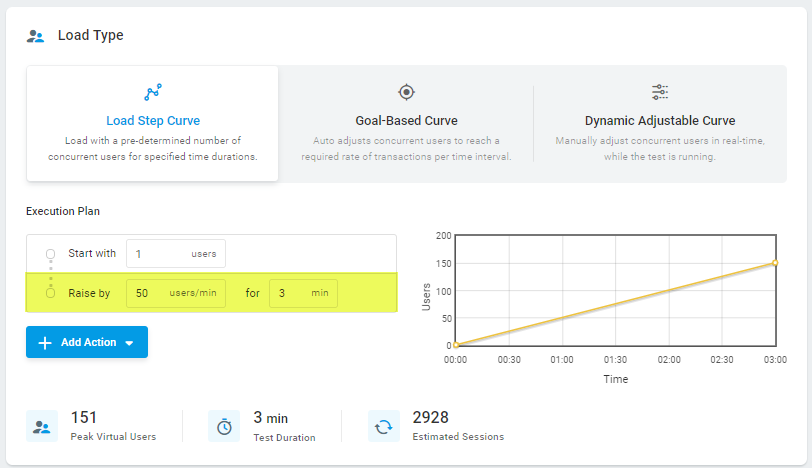JMeter Is the Open-source Load Testing Standard
JMeter has long been the open-source standard for load testing, having first launched in 1998. It’s important to stress here that open-source does not mean “free,” and while you can download JMeter at no cost, the proper use of it for load testing can be highly complex and require serious training and expertise and the ability to write custom scripts and code to execute load tests.
Contrast this to our LoadView platform, which is easy to use, features point and click scripting, real user and browser testing, and industry-leading support. While it may be tempting to save budget on a piece of open-source software, you might find yourself spending more for worse results in the long run.
Flashing forward to the present, what the world of load testing demands now is a lot more sophisticated than when JMeter first launched. Users want convenience, support, friendly interfaces, and load testing tools like LoadView which make scripting real user behavior as simple as pointing and click.
People don’t want unnecessary complexity in their load testing tools, although they do want those tools to be able to perform a range of complex tests that deliver accurate and actionable results. This is a major reason why many users prefer LoadView to JMeter.
What You Need for Professional Load Testing in 2023
An open-source load testing tool like JMeter can be tempting as it appears to be “free.” Here are some of the potential expenses you might be looking at if you attempt to use an open-source tool like JMeter rather than an all-in-one load testing platform like we offer at LoadView.
Hardware
While having the right hardware may benefit in terms of creating a “real testing environment,” most load testing is accomplished on the cloud today. In addition to lowering setup costs, cloud-based load testing can pinpoint the exact location where the software needs to put load, and can scale it accordingly. Additionally, bandwidth and storage can be literally “injected” into the system depending on the system’s load capacity. There’s no need to maintain your own hardware, or for a testing company to do so, for most of today’s load testing needs.
Maintenance
Unless you have a really savvy technician who can work the world of complicated hardware, you’d have to take care of any and all problems that arise while using the software yourself. Yes, guess what that means? More money spent on what came as an initial no-investment scheme.
Fixes & Innovation
Bug fixes can take months, and with an open-source project you’re at the whims of the project. With a paid load testing service like ours at LoadView, you can rest assured we work tirelessly to both support our users and further develop and maintain our tools to meet and exceed the standards of the load testing industry.
Expert Load Testing Consulting Services
You don’t need to go it alone in your load testing, and if you’re responsible for a website or application that drives serious revenue by way of leads and/or sales, you know uptime is critical. This is why a load testing consultant like ours at LoadView are a great resource. We’ll work with you one-to-one to help you meet and exceed your load testing requirements quickly, affordably, and efficiently. Consider us your expert partners for all things load testing.
But Really, Here’s What You Need from Your Load Testing (And It’s Not JMeter)
What’s going to give you the most satisfaction and results in terms of a load testing tool? Here are three key factors we emphasize at LoadView:
- UX for testing and reports
- Cloud execution
- Customer support
Firstly for any user to successfully implement a load test, it’s important that they spend less time figuring out how to use the software and more time actually testing. With LoadView you can begin testing in minutes, not hours or days, and can even generate complex user behavior with point and click scripting. You don’t need to be a highly technical user to begin to get value from LoadView within minutes.
Secondly if a load testing tool requires additional hardware, this will slow the process down. The same way you don’t buy a card when you travel abroad for a month, you don’t need your own comprehensive load testing infrastructure to benefit from modern load testing best practices. You can simply rent it from a company that specializes in load testing like we do at LoadView. We offer cloud-based, real user testing, so no additional equipment is necessary. You can simply register for an account and begin testing without needing to secure or maintain costly hardware.
Finally the ability of any load testing tool to provide a solid customer support service is essential for when people often run into difficulties while testing. The amount of written resources available on the internet for open-source load testing tools are vast, but nothing can compare to the individualized attention given to the user by the customer support team of a paid load-testing tool like our own LoadView.
At LoadView our entire focus is put toward giving you the tools you need to succeed at load testing, and we are always looking for ways to innovate and bring new and useful tools and resources to our users. With LoadView you have a dedicated team of load testing professionals backing you, in contrast to a nebulous open-source community project like JMeter.
Final Thoughts: Is JMeter Worth Using in 2023?
In short, it might be time to dump Apache JMeter for more advanced load testing tools that offer a wider variety of features including but not limited to playback recorders, visualization tools for results, and pin-point accuracy in terms of uncovering issues with your website or application. Save the time you would otherwise spend learning a complex, open-source tool and instead get testing today with LoadView.
Of course, even after this, some more technically competent power users may prefer to stick to good old JMeter, and their take on things is completely valid. They might be familiar with the software or like its less flashy, less textured nature of that tool. But the facts are clear: the world is moving forward, and the world is moving fast and at scale. More sophisticated load testing is a necessity for most serious websites and applications.
At LoadView, we empower developers to stress test their websites, APIs and applications with thousands of concurrent connections in real browsers from a fully managed cloud. There is no hardware to provision and no network to maintain. Leveraging Amazon Web Services (AWS) and Azure Cloud Services, we manage the network for you so you can focus entirely on executing your load tests, analyzing results, and improving your users’ experience of your website or application. For serious, professional load testing, check out LoadView and consider scheduling a one-on-one demo to get a hands-on look at what LoadView can do for your growing website.

